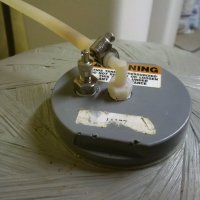robfun
New Member
First time posting here, so go easy on a newbie 
Had a plumber in to replace a leaking pressure water switch. (something I'll do myself next time). He told us the bladder in our tank is busted and we need to replace the tank. He pushed air in the top of tank to clear out any sludge and the air was coming out the blow down valve. I’ve done some more reading and I don’t believe he’s correct.
We have model Wellmate UT-150-SQ, which I believe is set up as a hydro-pneumatic tank since there is an air intake (micronizer-like) before the tank and plastic/vinyl tubing running from the top, although it doesn't appear to have an air volume control (AVC) unit attached. The top of the tank also has an air inlet valve, like a standard bike tire valve.
pic attachment link is here:
Questions:
Bladder:
Am i correct that the tank does not have a bladder? I read “One piece, seamless inner shell molded of premium high-density polyethylene which provides impact and corrosion resistance”: http://www.wellmate.com/files/knowledgebase/itemdownload/en/4003265-utseries-specsheet-mr14.pdf
AVC:
From the diagram here http://www.wellmate.com/Files/KnowledgeBase/ItemDownload/en/20198-ut-hp-sp-tanks-install-mr14.pdf
, I expect an AVC unit to be attached to the plastic/vinyl tubing from top of unit. There is no AVC. The piping runs upward and is connected with a T to the discharge lines from our water treatment systems. These lines then run down to sump pit (lines are not submerged). There is currently water in the pipe at top of tank. I’m not sure if the water is coming from the tank or is discharge from the treatment systems. Current setup allows for air to push out with resistance of water in line, but not easily drawn in. Is this okay?
Air Pressure:
What is the correct air pressure inside the tank and how should it be measured in the tank?
Cut in/out:
The plumber set a 30 differential for the cut in / out. Is 30 / 60 set up okay for the tank? Maybe, not a question that can be easily answered without knowing more specifics.
Had a plumber in to replace a leaking pressure water switch. (something I'll do myself next time). He told us the bladder in our tank is busted and we need to replace the tank. He pushed air in the top of tank to clear out any sludge and the air was coming out the blow down valve. I’ve done some more reading and I don’t believe he’s correct.
We have model Wellmate UT-150-SQ, which I believe is set up as a hydro-pneumatic tank since there is an air intake (micronizer-like) before the tank and plastic/vinyl tubing running from the top, although it doesn't appear to have an air volume control (AVC) unit attached. The top of the tank also has an air inlet valve, like a standard bike tire valve.
pic attachment link is here:

Questions:
Bladder:
Am i correct that the tank does not have a bladder? I read “One piece, seamless inner shell molded of premium high-density polyethylene which provides impact and corrosion resistance”: http://www.wellmate.com/files/knowledgebase/itemdownload/en/4003265-utseries-specsheet-mr14.pdf
AVC:
From the diagram here http://www.wellmate.com/Files/KnowledgeBase/ItemDownload/en/20198-ut-hp-sp-tanks-install-mr14.pdf
, I expect an AVC unit to be attached to the plastic/vinyl tubing from top of unit. There is no AVC. The piping runs upward and is connected with a T to the discharge lines from our water treatment systems. These lines then run down to sump pit (lines are not submerged). There is currently water in the pipe at top of tank. I’m not sure if the water is coming from the tank or is discharge from the treatment systems. Current setup allows for air to push out with resistance of water in line, but not easily drawn in. Is this okay?
Air Pressure:
What is the correct air pressure inside the tank and how should it be measured in the tank?
- Should the tank be empty (not likely, since no bladder)?
- Should it be full? (if yes, how full? Or does it matter?)
- Should air pressure in tank equal the current water pressure in the tank? Or be 2 psi below like with a bladder tank?
- Right now the water pressure shows 44 psi and the air pressure tank shows 40 psi. Is that okay?
Cut in/out:
The plumber set a 30 differential for the cut in / out. Is 30 / 60 set up okay for the tank? Maybe, not a question that can be easily answered without knowing more specifics.

